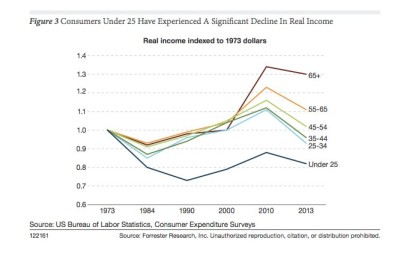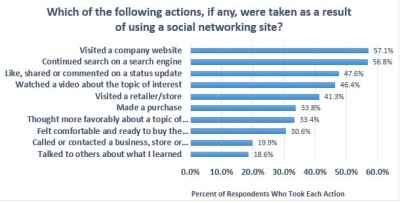Baby boomers: they know their worth, they know their strength, and they know their significance. After all, they represent the generation “that witnessed and participated in some of the greatest social changes in the country’s history,” including the Civil Rights Movement, the Women’s Movement, and the Vietnam War—not to mention beholding the “age of the computer, mobile communications, and the World Wide Web.”
And with over 76 million baby boomers in the United States, the considerable spending power of the post-World War II generation has lead to their coronation as “marketing’s most valuable generation,” states Nielsen research.
But why then do so many marketers overlook the buying potential of this age group, excluding them in favor of the 25-49 cohort? Research shows that this is a habit that marketers need to break. According to Neilsen research, by 2017 “50 percent of the U.S. population will be 50+. These consumers spend close to 50 percent of all CPG dollars yet less than 5 percent of advertising is geared towards them.”
Baby boomers are not the thrifty, penny-pinchers of the Silent and Great Generations. Au contraire. They were raised on consumerism and “currently account for nearly $230 billion in sales for consumer packaged goods, out-buying age groups in products like coffee, magazines, and diet soda,” reports the Huff/Post50.
So marketers take note. Baby boomers are a buying force to be reckoned with and your ecommerce strategies should reflect that.
Who Are Baby Boomers And What Makes Them Unique?
The baby boomer generation is comprised of anyone born during the “demographic post–World War II baby boom,” (hence the name), occurring between 1946 and 1964, making boomers between 52 and 70-years-old in 2016. These dates and corresponding ages are not set in stone, however, as the U.S. Census Bureau also uses the term “baby boomer” in a cultural context.
Some scholars argue that the baby boomer generation should be divided in two: boomers I, the true baby boomers (born between 1946 and 1954) and boomers II, Generation Jones (born between 1955 and 1965), as the life experiences, attitudes, behaviors, and societal influences would have been very different for boomers born closer to 1946 compared to those born on the other end of the generation spectrum.
And while there may be noteworthy differences between boomers I and boomers II, for simplicity’s sake, we are going to discuss the two groups of boomers as one unit here.
Baby Boomers Have Money To Burn
Unlike the preceding generation, which grew up during the Great Depression, baby boomers have money and they’re not afraid to spend it. The common fallacy is that spending declines for people in the 55+ age group.
But this simply isn’t the case. Research shows that baby boomers have comparable purchasing rates to people in the 25-54-year-old age bracket, spending slightly more than their younger cohorts on health and beauty care, alcoholic beverages, and fresh produce.
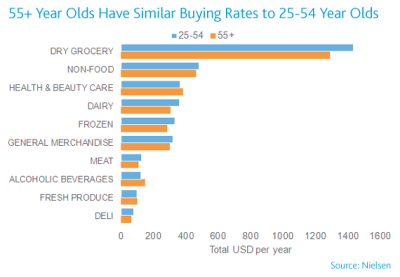
According to Steve Olenski, baby boomers “make up 70% of the nation’s disposable income,” and thanks to having decades of saving and investing under their belts, they are the overall “biggest spenders,” reports Sucharita Mulpuru of Forrester Research. Plus, “They’re also the only consumer segment that has made gains in real income since the 1970s.”
How Baby Boomers Shop
- Baby boomers, like other generations, love coupons, bargains, and sales.
- Baby boomers feel mostly at ease when researching, browsing, and shopping online.
- Retail websites are the strongest influence on baby boomers, followed by advertising and salespeople; word-of-mouth from friends, family, and social media doesn’t have as big of an effect.
- Female baby boomers are more likely than males to talk about their shopping experiences via social media.
- While tech-savvy, baby boomers are less likely to use devices like smartphones and tablets as shopping tools.
- They watch fewer online videos than younger generations watch.
- Baby boomers don’t care as much about pricing as millennials do; baby boomers are more loyal to their favorite brands and styles but still not exclusively so.
They Use Social Media But Not The Same Way As Millennials
“Boomers are the fastest-growing group on Facebook with an 80% surge in users between 2010 and 2014,” reports David Weigelt. And according to an online survey of 1,000 people between the ages of 60 and 69 conducted by DMN3, “An overwhelming 82.3% of Boomers belong to at least once social networking site,” with Facebook being the most popular, followed by LinkedIn.
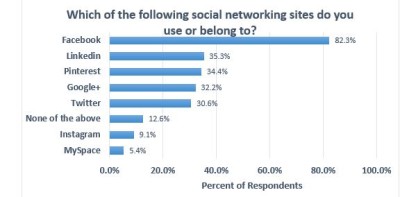
And while baby boomers are definitely active on social media, they do tend to use it less than younger generations. Based on the aforementioned survey, respondents indicated that they typically spend between one and two hours a week on social media. However, it should also be noted that a significant percentage (15.5%) did say they spend eleven or more hours a week on Facebook.
And what about how baby boomers are influenced by social media?
 Pamela Lockard: “Baby Boomers take action based on what they see on social media, and most of the time it’s focused on finding more information.
Pamela Lockard: “Baby Boomers take action based on what they see on social media, and most of the time it’s focused on finding more information.
More than half of Leading-Edge Boomers will visit a company website or continue the search on a search engine after seeing something on a social networking site.”
They Think For Themselves And Don’t Appreciate Condescension
One of the characteristics of the baby boomer generation, which has also been coined the “me” generation by writer Tom Wolfe, is that as baby boomers were growing up, they had cultural aspirations of “self-realization” and “self-fulfillment,” resulting from coming of age during a time of introspection and experimentation with a variety of cultural foundations, including sexuality and new age spirituality. It was a time of hot tub parties, discos, lifestyle products, and EST (Erhard Seminars Training)—oh, and don’t forget about Woodstock.
Baby boomers differ significantly from their parents’ generation, whose values of self-sacrifice, hard work, and thrift, resulted from growing up during the Great Depression. And generally speaking, the generation preceding the baby boomers expresses a stronger loyalty to institutions and traditional religious beliefs—values that baby boomers gradually moved away from.
 Steve Olenski: “The Woodstock Festival was much more than a concert featuring the likes of Joan Baez, Janis Joplin, the Grateful Dead and Jimi Hendrix; it was a counter-cultural event which symbolized, among other things, that the baby boomers were not going to be trussed up by their parent’s morals and lifestyle.
Steve Olenski: “The Woodstock Festival was much more than a concert featuring the likes of Joan Baez, Janis Joplin, the Grateful Dead and Jimi Hendrix; it was a counter-cultural event which symbolized, among other things, that the baby boomers were not going to be trussed up by their parent’s morals and lifestyle.
They would think and act for themselves—and they still want to be thought of that way. The least hint of patronizing the baby boomers will flatten any marketing campaign, just as Wile E. Coyote was flattened by the Road Runner.”

“Woodstock cover couple still together 40 years later”
Baby boomers may not be in their 20s or 30s anymore, but that doesn’t mean they no longer possess the same spirit they had when they were younger. So actively engage with them and use a personalized approach to garner their attention. “Remember this when targeting the Boomers: create content that will make them feel like they earned or deserved the product or service you are offering,” adds Kimberly Grimms on Social Media Today.
How To Customize Your Digital Marketing To Appeal To Baby Boomers
Baby Boomers Don’t Want To Feel “Old”
“Senior,” “elderly,” “old,” “aged,” these are all anti-buzz words that baby boomers hate to hear and understandably so. Baby boomers resent being perceived as “over the hill,” especially since the description doesn’t even fit. Baby boomers have money, they are active, and they want to live the good life, bucket-listing their way through their retirement years.
And even though changes may occur in their lives, it’s all about how you spin it, even if one of those changes involves needing to wear Depends, which are now marketed as an alternative type of underwear versus “adult diapers.” Also, Aliza Gans writes, “Depends uses actors in their 40s and 50s to target consumers who are typically in their 60s and beyond,” thus removing even more of the stigma and the implication that wearing Depends equals nursing-home-ready.
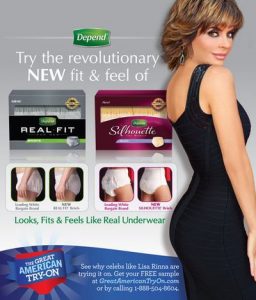
 Aliza Gans: “According to [Ann Fishman, founder of Generational Targeted Marketing], the AARP also meets the gold standard of brands that know how to market to those in their golden years. The site has tailored its interface for older people new to the web, and has launched its TEK program (Technology, Education, Knowledge) with bold-colored, user-friendly tutorials, including lessons on how to use hashtags and even “Cyberproof Your Phone.”
Aliza Gans: “According to [Ann Fishman, founder of Generational Targeted Marketing], the AARP also meets the gold standard of brands that know how to market to those in their golden years. The site has tailored its interface for older people new to the web, and has launched its TEK program (Technology, Education, Knowledge) with bold-colored, user-friendly tutorials, including lessons on how to use hashtags and even “Cyberproof Your Phone.”
Still, nowhere does the AARP mention that its patrons are senior citizens. Instead, it uses phrases such as ‘life re-imagined,’ ‘real possibilities,’ and ‘you’ve still got it.’
‘AARP did an excellent job of redesigning itself to become a good vehicle of something people are attracted to,’ Fishman says. ‘They put movie stars on the cover of their magazines—they have Goldie Hawn…If they aren’t afraid to be on AARP, then it’s okay for us to be on AARP.'”
The key is to bridge the gap “between retirement and the hip online trends of today,” Gans continues. And how you can achieve this with your business is to create content, instructions, and sales copy that allows your customers to use your products or services in a progressive but accessible way rather than using restricting labels that pigeonhole them to particular age groups.
Mesh Digital Marketing With Traditional Media
Merritt Graphics Print Solutions: “These days it’s easier than ever to integrate your digital marketing campaigns with more traditional media like direct mail, and boomers are likely to be more comfortable engaging with a brand if they’re introduced to it via the traditional channels they grew up with.
Digital and variable data printing make it possible to create personalized mailers and catalogs that appeal to the same sense of individualism as custom landing pages and PURLs. Custom URLs, QR codes, and promo codes can be included in printed promotions to build online traffic and engagement. The idea here is to bring your digital presence to the consumer, rather than hoping they’ll find it on their own.”
Be Relatable And Avoid The Hard Sell
Baby boomers want to feel cared about, they value honesty, and they don’t want to feel like they are being pushed or coerced into making a purchase. In other words, they don’t want to be “sold.”
In a CIO article, Sandra Powers of LawyerReviews.com is quoted as saying, “Strive to be honest and upfront and factual about your product offerings…We frequently display pictures of baby boomers in our newsletters and other marketing materials. Baby boomers better identify with your products if the marketing materials include pictures of people that look like them.”
Similarly, in the same article Danielle Kunkle of Boomer Benefits suggests, “have a rich About Us page [on your website] that shows [boomers] who they are buying from—and include pictures of your staff [if appropriate],” adding that boomers “value businesses that care about their community.” So try incorporating a touch of philanthropy in your business and see how it boosts your appeal to baby boomers. For instance, Danielle’s company “funds a scholarship for baby boomers who return to school as an adult,” providing her potential clients with another reason to feel good about engaging with Boomer Benefits.

Moreover, Jennifer Lonoff Schiff says, “Explain what it is you are offering, and the value of your product or service, without being pushy or patronizing.” Baby boomers like to do research beforehand to ensure they are making informed decisions, and they also like to ask questions. This generation isn’t trigger happy when it comes to buying online so tone down the hard sells and keep it honest.
Make Sure Your Customer Service Is Top-Notch
Providing excellent customer service (which you should be doing anyway) is one of the key ways that you can win the hearts of baby boomers, who get a lot of value out of one-on-one interactions—whether they occur in person at a brick-and-mortar store, over the phone, or online in a chat session.
Baby boomers also love user-friendly websites that enable them to easily navigate to areas where they can find answers to their questions and ways to contact you directly. According to Merritt Graphics Print Solutions, “More than any other demographic boomers tend to want to actually interact with someone before they make a purchase or other financial decision.”

And don’t discredit the power of the telephone. Be sure to list a phone number as one of the ways that people can get in touch with you. Having an abundance of information and support available online is great, but “it’s almost always worth it to make it easy for someone to pick up the phone and call you to help complete a transaction,” says Edward Nevraumont, CMO, A Place for Mom. Even travel websites like Expedia still complete a quarter of their bookings over the phone.
Offer Plenty Of Online Resources
 Valerie Guglielmi of Harp Advertising + Interactive: “Instead of assuming that anyone over 50 isn’t all that tech-savvy, think again. According to ImmersionActive.com, this age group is actually the fastest-growing demographic online. They spend more time per week online than they spend watching TV.
Valerie Guglielmi of Harp Advertising + Interactive: “Instead of assuming that anyone over 50 isn’t all that tech-savvy, think again. According to ImmersionActive.com, this age group is actually the fastest-growing demographic online. They spend more time per week online than they spend watching TV.
Immersion Active also shared that, ‘the Internet is the most important source of information for Boomers when they make purchasing decisions.’ That being said, it’s extremely important to create and post informative sources about your products or services online, hopefully on your website or company blog. Explain the benefits of the offerings your company provides as a way to convince baby boomers to make a purchase.”
Don’t Assume All Baby Boomers Are Alike
As previously mentioned, there are a ton of baby boomers out there. And so, you don’t want to cast too wide of a net when you’re marketing to them. You want to narrow your focus to the boomer segment that’s most likely going to be interested in what you have to offer and then identify the communication channels they use most and craft copy that specifically targets that segment. If you recall, some sources do break up the baby boomer generation into segments I and II based on when they were born.
So keep that in mind when coming up with your marketing plan, as older boomers may be less likely to use social media or shop online than younger boomers who use social media, especially Facebook, and shop online regularly.
Conclusion
The marketing industry typically spotlights millennials, concerning itself primarily with what millennials want, how they shop and interact online, and how to appeal to them. And while millennials are most definitely a buying demographic that wields significant power to influence and shape trends, they do not possess anywhere near the purchasing clout of their predecessors, the baby boomers, whose “spending power…is predicted to be $15 trillion worldwide by the end of 2019.”
And to quote Jody Holtzman, head of AARP’s Thought Leadership unit, “You’d have to be an idiot to turn your back on this humongous growth market.”
Have something to add? Leave a comment.
Be sure to like, share and subscribe.





